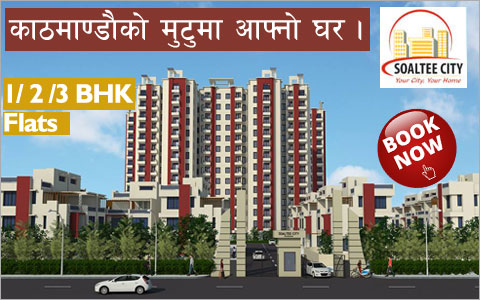National News
The government is set to deny permits to build new houses on plots smaller than 2.8 annas while roads in residential areas have to be a minimum of six metre wide, according to new building guidelines currently under consideration.
A copy of the proposed guidelines received by the Post reads: “Local roads should be stretched to three metres on either side from the central line.” Concerned agencies—municipalities and VDCs—will not issue building permits if the requirements are not fulfilled, the draft says.
Earlier, there was no strict regulation regarding the width of the road while the minimum area required to build new houses was 80 square metres (approx 2.5 annas). If the measures are approved, semi-detached housing (houses built side by side) would not be allowed to exceed three storeys.
The flaws in urban planning in Kathmandu and other cities of the country, laid bare by the Great Earthquake, had prompted the Ministry of Urban Development to form an Urban Planning and Regulation Amendment Recommendation Commi-ttee to formulate new urbanisation policies as per international standards. The committee has already forwarded its recommendations to the ministry and awaits a Cabinet nod.
The draft guidelines state that outer pillars of a house should be built at least one metre within the boundary of the plot. Houses cannot be erected on plots filled with more than one-metre layer of soil.
Unlike in the past, homeowners also need prior approval to construct balconies.
Another major change in building code will see that fences around a house are not taller than four feet. But installing safety nets up to 0.5 metres high on top is allowed.
The guidelines also make soil testing and seismic analysis mandatory for constructing buildings taller than five storeys, also called high-rise buildings. Soil testing is a geotechnical study of a land’s load-bearing capacity while seismic analysis is the calculation of the response of a building to earthquakes. High-rises will also be required to channel rainwater into the earth and only excess water that the earth cannot soak up can be directed to gutters.
Land and house pooling projects for commercial purposes will need to prepare a master plan subject to approval from the local body. The local development authority and Urban Development Committees have been entrusted with overseeing land transactions and construction of communal residences and public buildings.
No structures apart from roads, sewerage lines and gardens can be constructed on the riverbanks. Buildings have to be at least 10 metres far from small streams and 30 metres from rivers while they cannot be constructed on hill slopes and areas prohibited by the Department of Mines and Geology.
The guidelines also require trained professionals to construct buildings. Officials issuing building permits in violation of the rules will be punished, says the draft.
source: the kathmandu post,14 august 2015
- 9th Nepal Buildcon International Expo 2024
- Real Estate Expo 2023
- NRB raises housing loan limit to encourage home constructions
- Nepal Rastra Bank (NRB) Monetary Policy 2080-2081
- New Price of Land in Kathmandu Metropolitan City, Nepal
- Capital Gains Tax Rate on Real Estate Transactions in Nepal 2080-81 ( 2023/24 )
- Kathmandu metropolis implements free parking policy for commercial buildings and hospitals

![[X]](https://www.housingnepal.com/images/popup-close-button.png)































































































































































































































































































































































































 Facebook
Facebook
 Delicious
Delicious
 Digg
Digg
 Reddit
Reddit
 Stumble Upon
Stumble Upon









